It could be the ideal balmy summer evening: watching a movie under an idyllic starry sky. On the autumnal evening of Friday 6 September, however, open-air cinema Zienemaan en Sterren turns out to be more of an exercise in endurance. It rains, the temperature drops, but the Groningen audience remains unperturbed: head for it and umbrella open.
"Every city had an open-air cinema except Groningen. That's ridiculous, of course!" says organiser Jorine Witte. "It's such a good concept to introduce people to great films in an accessible way," says programmer Harmen Huizenga." Jorine and Harmen worked together at Zienema, the cinema of pop podium VERA where they showed special films every Tuesday night. Jorine: "We felt called to put an open-air cinema on the map in Groningen too." So Zienemaan en Sterren started small once in 2011 on Groningen's Ebbinge Quarter with a wide film screen in front of a lawn.
The backdrop for the ideal Instagram photo
Meanwhile, Zienemaan en Sterren is experiencing its eighth edition and has become the largest open-air cinema in the Northern Netherlands. The former sugar union grounds are home to this three-day film festival. It is a beautiful location and looks like the setting for the ideal instagram photo: behind the film screen, the sugar factory is bathed in a mysterious purple glow, the coloured lights of the bars contrast cosily with the industrial setting. On Friday, September 6, I visit the festival. Seeing Moon and Stars then lives up to its name with a real Russian space film: Salyut 7.
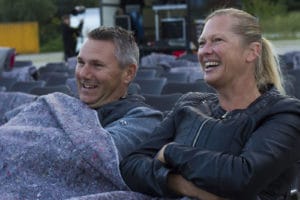
The Fatboys are invitingly laid out, cosy rugs hang over the chairs and the first guests are already using them. Linda and Rinze from Roden are there early. In the front row, they are ready for a trip to space. Google brought them to Zienemaan en Sterren: "We are having a night out in Groningen and were looking on the internet for a fun event. It was either this or chair dancing on the Grote Markt," Linda says. A shower is planned, but are they prepared for the rain? The short answer is "no." They crawl a little further under their blankets.
"Russian Spaceflight is much cooler than NASA!"
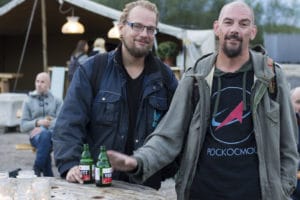
Equally ill-prepared are Remon and Peter. I find these two burly men -as usual- at a bar table with a beer in hand. "We are very well prepared for the rain," jokes Peter, "as in: we hope very hard that it will not rain." "Look!" points out Remon hopefully, "that cloud over there is already pulling away!"
Neither Remon nor Peter had been to Seeing Moon and Stars before, while they both work at VERA and are thus familiar with the concept. It was the film that was the deciding factor this time. Remon proudly displays his T-shirt. Peter reads Pockockmoc, "Roskosmos," explains Remon, who turns out to be a connoisseur of Russian spelling, "you can also write my name as 'Pemoh'." According to Pemoh, what makes a Russian film about space travel so appealing: "Russian space travel is much cooler than NASA; they were everywhere before." "And the story from the film is true." adds Peter. "Ah, like the American moon landing?" I ask. Peter laughs. He makes his fingers into inverted commas, "Yes, 'true story'."
"I have nothing to do with Science-Fiction"
On the Friday night of Seeing Moon and Stars, the space theme is reflected in several ways: there is a rocket provided by sponsor Vedett and a space playlist blaring through the speakers. While David Bowie with Space Oddity counting down for the film; 10, 9, 8... a visitor behind me counts down for something else: "3, 2, 1 hoppa", using his buttocks to dry the wet seat. This visitor appears to have not read up as well: "I have to tell you very honestly: I have nothing to do with Science-Fiction," he tells his companion. "Huh, but I thought you were one of those spaceman was!" "No I like Space Oddity das quite something else!"

The film of the evening Salyut 7 has nothing to do with Science-Fiction to make. Salyut 7 tells the true story of the most technically challenging mission in space exploration to date. When the Russian control centre loses contact with the unmanned space station Salyut 7 in 1985, panic strikes the Soviet Union. When a spinning unmanned object weighing over 20,000 tonnes crashes into Earth, a catastrophe will occur. Of course, that catastrophe is compounded when it coincidentally lands in the US in the middle of the Cold War. There is only one thing to do: man the space station. Salyut 7 is a chillingly exciting film and offers a refreshingly different perspective.
"Russian space films are much more down to earth"
"Most space films are American," says programmer Harmen, "and yet there was another major player in space: the Soviet Union." According to Harmen, Russian cinema is slow, subdued and full of doubt with a touch of melancholy. He wittily notes, "Russian space films are much more down to earth. There is more focus on the human, the existential. Salyut 7 has the best of both worlds: It falls exactly between the bombastic of Hollywood and the more subdued work of the Russians."
During the film, dark clouds take away the view of the moon and stars. While the film beautifully shows weightlessness in a scene where satellite Salyut 7 is full of floating water droplets, in Groningen the drops fall down. Rain ponchos go out of the bag and visitors move their seats to unfold colourful umbrellas. It is still atmospheric on the festival grounds; with a little imagination, the umbrellas look like umbrellas. The temperature is starting to drop, but it is still not as cold as in the Russian space station on screen. Nor are the Russian astronauts complaining in flying freezer Salyut 7 "It's like Sochi in winter," says one and shrugs his shoulders.
"Two years ago it was worse and even then everyone stayed put"
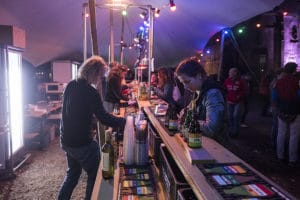
During the break, visitors warm up over wine and tea, but no one leaves. Nait soezen (don't whine) seems to be the motto. "Well you see," says Harmen, "even the rain doesn't bother people." It surprises me, just as it surprised the organisers themselves two years earlier: "Two years ago, the rain was even worse and even then we noticed that everyone stayed put. At least it gave us confidence that we could still go ahead," Harmen says. "As long as the film is catchy enough, the audience will keep watching." At Salyut 7 is the case. The suspense is constantly palpable through the hugely bombastic soundtrack. The audience can fortunately breathe again every now and then in brilliant dizzying shots reminiscent of Gravity.
"The first year was really a eye-opener"
Salyut 7 is a film that can handle the open air. Harmen: "When selecting a film, I always keep in the back of my mind whether the film will stand up in the open air. Some films are beautiful, yet somewhat subdued and small. The dialogue has to come across well." Jorine adds: "In the first year, we had chosen very loud films. We thought then: people are distracted super quickly, so we really have to have films that keep drawing attention. That first year was really a eye-opener for us, as it turned out: everyone stayed neatly seated in rows. It was much more of a 'cinema' than we had expected. The following year, we programmed some quieter films."
"I try to programme as diverse as possible"
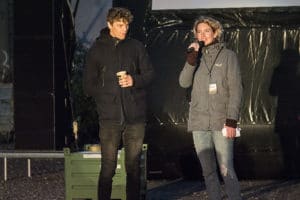
Photo: Obed Brinkman
Stretching the conventions of cinema is precisely something Harmen and Jorine are trying to do at Seeing Moon and Stars. "We have been doing the concert film for a few years now. In doing so, we hope that people might go dancing anyway, that there is some hustle and bustle, just as if you were really watching a concert. Having previously shown concert films of Herman Brood, David Bowie and The Talking Heads, for the eighth edition it is time for concert film Monterey Pop. "I always try to programme as diverse as possible," Harmen explains, "because then you also appeal to a very diverse audience. For Friday we have Russian and space travel, for Saturday a concert with hippies and flowerpower, then Sunday punk and aliens in How to Talk to Girls at Parties. Thus, there is something for everyone."
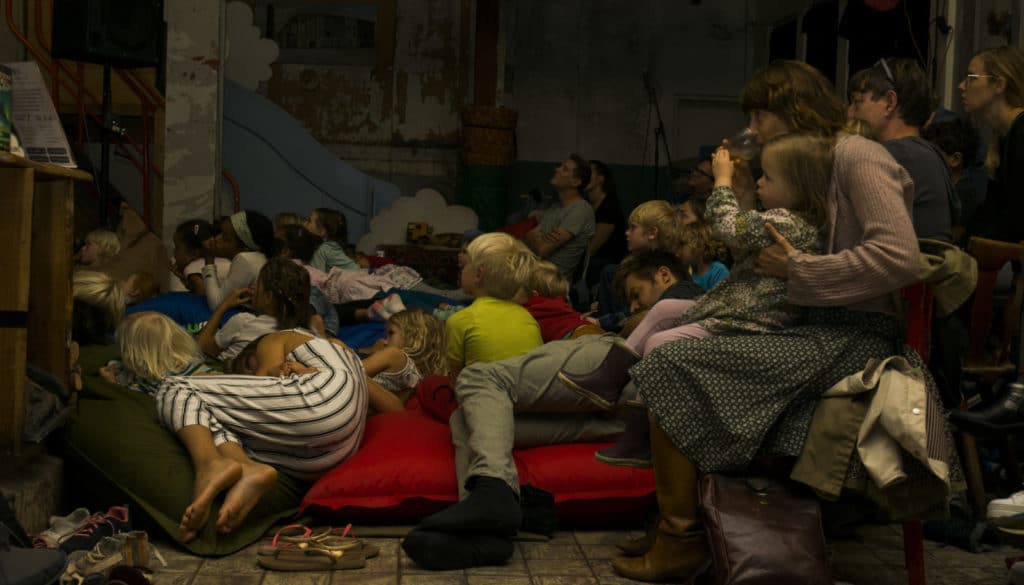
Even children are at the right place at Zienemaan and Stars. For three years, the organisation has been showing children's films in the afternoon in "Zienemini". The cosy café in the Sugar Factory, the Cloud Factory, lends itself perfectly to that setting. Mother Nathaly visits on Saturday afternoon The animals of the Hakkebakke forest with her daughter and her daughter's friend. "We come to Zienemini every year. It is much more fun than a regular cinema. The children can quietly leave their seats to play here." Her daughter comes to fetch her: "Quick mama! The film is starting!"
"We always try to do more than just show a film"
For film festival Seeing Moon and Stars, showing a film is more than just on play press. Jorine: I find it very unfortunate that the current cinema industry only plays a film; you can just do that at home on the couch. We always try to do more than just show a film. We give an introduction and have an expert speak if possible. So that we really add something with our film events." For instance, a good short film is always shown before the main film. A genre there is no room for in regular cinema.
"The difficult thing about an outdoor event is that you never know in advance where you stand," says Harmen. "Last year we had a perfect edition, windless and an evening sun, then you're sitting with 700 people in no time. When it rains, visitor numbers are significantly lower." Still, a rainy night at Zienemaan en Sterren makes it clear that Groningers are not sugar-coated. Prepared or not, they don't let a bit of water scare them away.
Aftermovie: Joris Bakker
